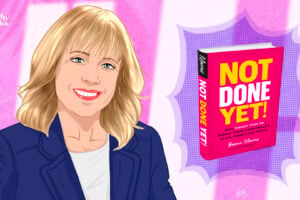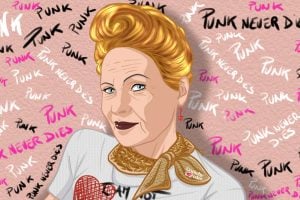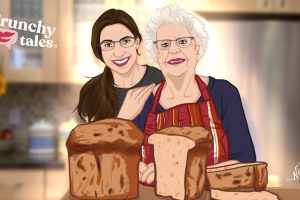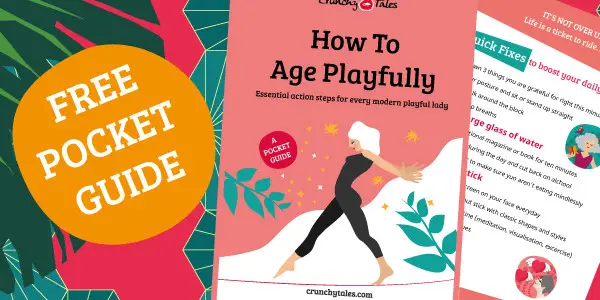Jacynth Bassett: “Ageism Is Never In Style”
Challenging the Fashion Industry’s ageist attitudes and barriers and celebrating style at every age is the mission of Jacynth Bassett, the founder of the-Bias-Cut.com (the first pro-age online independent fashion boutique) and brain behind the movement #AgeismIsNeverInStyle. Named as an “Ageism-Fighting Trailblazer” by Global Health Ageing, Jacynth is swiftly becoming recognised as one of the leading pioneers of style at every age.
Jacynth, you are quite young but able to look ahead and care about midlife issues. What inspired you to set up the-Bias-cut.com?
I founded the-Bias-Cut.com after growing saddened and frustrated at seeing women, like my mum, being treated as invisible or irrelevant in the eyes of the Fashion Industry, largely due to their age. My overall mission is to fight ageism within the Fashion Industry. We live in a society where we’re repeatedly told ageing is something to fear. And yet it’s a part of life, something that cannot be stopped and is actually a privilege that sadly many are not fortunate to experience. So we should be embracing and celebrating it, not the reverse. Ageism is the only ‘ism’ that every single one of us could experience, so it’s really important that we all engage in the conversation and tackle it. And whilst ageism is genderless, women, in particular, are more subject to it due to sexism… men become ‘silver foxes’, whilst women become ‘spinsters’ and ‘mutton dressed as lamb’. We need to redefine what it means to age so that older women feel confident and visible, whilst younger women have something to aspire towards.
Do you think people’s attitudes towards stylish older women are changing?
In the last 5 years, there’s definitely been a shift. It’s certainly more accepted that women can both grow older and be stylish. In particular, this has a lot to do with celebrities, such as Jennifer Aniston, Sandra Bullock, Jane Fonda, Michelle Obama, who are getting older and showing they are just as fabulous as they were when they were younger. And, even in some cases, such as Celine Dion and Sarah Paulson, female celebs are going through style ‘renaissances‘ with age, wanting to have more fun, and be more daring with their fashion choices. Also, more 40+ women are taking to social media to share their outfits, inspire others, and defy stereotypes, which is leading to a wider recognition that older women can be stylish. Influencers such as Iris Apfel, Advanced Style, Judith Boyd of Style Crone, and Lyn Slater of Accidental Icon have been instrumental here. However, there’s still some disparity between generations. Whilst women in their 40s and beyond are collectively acknowledging and proving that style doesn’t fade with age, generally speaking, the younger generations are taking longer to catch up. There’s still a lot of stereotyping and subconsciously ageist ideas; even in cases where they love and admire the style of someone like Jennifer Aniston or Iris Apfel, she’s considered the exception to the rule. But what is encouraging is that I’m increasingly being contacted by fashion students who are interested in engaging with the issue of ageism in Fashion, recognising that style has no relation to age. In particular, if they’re seeing their loved ones such as their mum, aunts or grandmas defying the stereotype, then they’re starting to reshape their attitudes
How about the fashion industry? Is it becoming more aware regarding ladies over 40s needs?
It is becoming more aware, but there’s still a long way to go. At one of end of the spectrum, there are more brands who are tuning into this demographic. It’s possible it’s just because they’ve cottoned onto the financial opportunity, but either way, at least they are becoming more aware. However, whilst we are starting to see more women over 40 being featured in campaigns and on the runway, but it’s generally tokenistic. The majority of ‘older women’ featured in campaigns are typically tall, slim, Caucasian with white or grey hair. Moreover, there’s usually just one or two women featured, who are meant to represent all women over 40. But why should someone for example in her 70s be representing a woman in her 40s? There’s a 30 year age gap there. We wouldn’t expect a woman in her 20s to identify with a woman in her 40s, so why should it be any different? We also need to see more consistency. If a brand wants to celebrate age diversity, then that needs to be engrained into its DNA. Otherwise, it just comes across as inauthentic and opportunistic. There are brands that have featured older women in campaigns but if you go shopping on their website, it’s back to young models again. This needs to change. Moreover, it’s not as simple as featuring an older woman or two in a campaign – it’s about understanding who she is, her lifestyle, her wants, and her preferences. Women’s bodies naturally change as they get older, so the garments themselves need to cater to this. At the other end of the spectrum, there’s still the belief that youth is queen, with some designers, convinced their brand’s reputation will be damaged if women over 40 are seen advertising or wearing their designs. A designer even once admitted to me that he turned down an A-List celeb in her 80s wearing one of his dresses at the Baftas primarily due to her age. And on another occasion, a designer’s agent acknowledged that their core customer is over 40, but the designer would never want to admit it. But things are certainly getting better. Just 4 years ago I’d be at trade shows and 9/10 designers would be horrified at the prospect of celebrating women over 40. Now, it’s more half and half.
You believe style doesn’t fade with age, it evolves. How does it change with time and personality?
Whilst there are obviously exceptions to the rule, generally, women are more conscious of trends and wanting to ‘fit in’ when they’re younger. So their style is heavily trend-driven, with less individuality and personality. As a woman’s confidence develops with age, she becomes more comfortable with who she is, what she likes and doesn’t like, and what suits her and what doesn’t. And this is mirrored through her evolving style; she may still want to incorporate nods to trends she likes to keep her look fresh and modern, but she’s less likely to be dictated by what the fashion editors are saying she should and shouldn’t be wearing. Instead, her style becomes more personal, and a reflection of who she is.
Madonna and Helena Christensen have been criticised as dressing inappropriately because of their age. What’s your opinion on this?
This always intrigues me – Madonna’s style, in particular, seems to spark very negative reactions. I think it has something to do with the perception that women who dress like her are in denial of their age, desperately clinging onto youth. However, I think such criticism is unfair and damaging. Whatever her age, a woman should be able to dress however she wants. And who are we to decide what is and isn’t ‘age-appropriate’? Some women may not wish to show off the skin as they get older, but there are others who feel strong, confident and sexy when they do, and that’s all that matters. Fighting ageism is about choice – a choice to age however you want, without external pressure or judgement from society. So it’s still ageist to attack the likes of Madonna and Helen Christensen for not ageing in the ‘right way’. It just makes other women afraid of ageing their own way too. Whatever their reasoning for dressing how they do, that’s up to them, and instead we should be celebrating and commending them as women who are continuing to thrive and be successful in their respective ageist industries.
Which key pieces would you suggest to a middle-aged lady who is struggling to find her style?
Every woman should have a pair of dark blue, slim-fitting jeans in her wardrobe. They’re flattering, go with almost anything, and make getting dress effortless as they’re the perfect foundation piece. Other pieces are a fab statement jacket, a beautiful blouse or shirt that can easily be dressed up or down, a great pair of tailored trousers, and few choice ‘special’ pieces such as a gorgeous skirt or dress for parties and formal occasions. A lot of women feel they shouldn’t invest in pieces if they rarely have the ‘occasion’ to wear them, but these days dress codes are so fluid, and there are very few pieces that can’t be adapted and dressed down in some way for a more casual affair. And it’s important to treat yourself to something special from time to time!
What do you look for when you source new labels?
We source stylish, contemporary womenswear labels with a unique point of view. All of our garments and accessories focus on exceptional quality fabrics and materials, beautiful fits and a modern, yet timeless style which goes beyond seasonal trends. We don’t support disposable fast fashion due to the environmental and labour costs, and select designers who focus on quality designs made with integrity and through fair manufacturing processes. Everything we select is to last and be loved for years.
What’s your best selling item and why do you think it sells well?
Knitwear is our best-seller, in particular, cashmere. There’s a lot of cashmere out there, but a lot of it is either poor quality and/or classic, simple designs. Instead, we only sell pieces that are both beautiful qualities and have a playful edge, which really stands out and attracts customers. Plus fun knitwear is so easy to wear as it goes with virtually anything and, if you’re in the UK, you’re going to be wearing it more often than not anyway! Also, because we’re online, customers who haven’t shopped with us yet may feel more comfortable first buying cashmere as they have a better idea of what they will get, and the fit with knitwear is less of an issue. So a cashmere jumper is often a good entry piece. But what’s really nice is then seeing how customers return and increasingly start to buy more ‘daring’ pieces such as a dress or jacket because they trust our quality, and their style confidence is growing.
You work on the principle that if you wouldn’t wear it, then why should women over 40? Can you explain your philosophy better?
The majority of brands treat women over 40 as secondary customers. Even if more women over 40 shop with them than those younger, their designs cater more to younger women – namely their bodies and lifestyle. So there are far fewer options for 40+ women, with them often left with the ‘lesser’ styles – typically boring, safe or frumpy. A few years ago, I was at a designer fashion show with my mum, which was followed by a pop-up shop and, despite the designer claiming she catered to all bodies, the majority of her stunning, printed pieces were for tall, slim, younger women. So my mum asked her what she could wear, and the designer suggested a plain black shrug…. And I’ve seen and heard very similar stories with other women. Why should women over 40 only have second best? As someone in my 20s, I don’t have to resort to these styles, so nor should a woman in her 40s and beyond. We might a piece differently, but what it boils down to is that, if I wouldn’t feel good in it, then a woman in her 40s should have to wear it either. She should have just as many options to choose beautiful, stylish pieces as someone younger.





